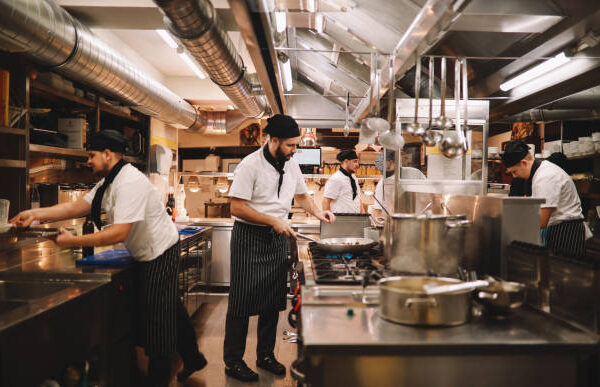The foodservice industry is constantly evolving, not just in terms of new culinary techniques, but also in the ways restaurants operate behind the scenes. With increased attention on sustainability and resource efficiency, reducing waste has become a key area of focus for many restaurant owners. If you’re looking for ways to streamline operations, reduce costs, and increase sustainability, waste reduction should be at the top of your list. Here, we will explore some strategies that can help reduce waste in your restaurant while improving overall efficiency, productivity, and profitability.
Waste in the Restaurant Industry
The foodservice industry is notorious for its high levels of waste, whether it’s from spoiled food, discarded packaging, or inefficiencies in the kitchen. According to recent studies, the average restaurant throws away a substantial portion of food every day, which not only harms the environment but also results in wasted resources and lost profits. In addition to food waste, inefficiencies in energy, water usage, and even employee time can contribute to higher costs and operational hiccups.
By reducing waste, you can directly improve your bottom line while also making your restaurant a more sustainable business. The key lies in adopting a comprehensive waste reduction strategy that addresses all aspects of your operations, from food production to customer service.
Creating a Waste Reduction Culture
One of the most effective ways to reduce waste in your restaurant is by fostering a culture of waste reduction among your entire team. It starts with leadership. Owners and managers need to set clear expectations and lead by example. Waste reduction should be a shared responsibility across all levels of the business, from the kitchen staff to servers to the cleaning crew.
Training your team on the importance of waste reduction and providing them with the tools and knowledge to minimize waste is crucial. For instance, kitchen staff should be trained on portion control to avoid over-preparing food, which can lead to unnecessary waste. Similarly, servers can be encouraged to minimize food waste by offering proper portion sizes and educating customers on take-home options.
Building a waste-conscious culture also means empowering your staff to suggest improvements and contribute ideas. Encourage them to speak up when they notice areas where waste is being generated unnecessarily, and reward initiatives that lead to waste reduction.
Optimizing Inventory Management
Effective inventory management is one of the most powerful tools in the fight against waste. Properly managing your inventory can help reduce the amount of food that spoils, become outdated, or is thrown out due to over-ordering. The first step in optimizing inventory is keeping track of what you have on hand and ensuring you’re ordering only what you need.
Implementing a just-in-time inventory system can drastically reduce food waste. By aligning your purchasing with your actual demand, you can avoid overstocking ingredients that may go bad before they’re used. An essential part of inventory management is also tracking expiration dates and rotating stock, ensuring that older items are used first, thus preventing spoilage.
You can also take advantage of technology to help optimize inventory. Many restaurants are now using software solutions that help track inventory levels, predict demand, and automatically place orders based on usage patterns. This level of sophistication can dramatically reduce waste while ensuring you’re never caught with excess food that will eventually need to be discarded.
Waste Reduction through Menu Engineering
Another key area where waste reduction can make a significant impact is menu design. Your menu should reflect not just what your customers want, but also what’s practical in terms of ingredient utilization. One common issue in restaurants is having a menu that features dishes with overlapping ingredients. If you offer a wide variety of items but some ingredients are only used in one or two dishes, those ingredients may end up being wasted when they aren’t used quickly enough.
Menu engineering involves evaluating each item on your menu to identify which dishes are popular and which ones might be contributing to unnecessary waste. By analyzing sales data, you can reduce the number of items that are rarely ordered or tweak recipes to use ingredients more efficiently.
You can also design your menu to encourage customers to order only what they need. Smaller portions, customizable dishes, and shared platters can all reduce the likelihood of food being left uneaten. Offering “half portions” or smaller, more affordable options may appeal to guests who don’t want to waste food or overeat.
Composting and Recycling
Even with the best waste reduction practices in place, some waste is inevitable. However, that doesn’t mean it has to end up in a landfill. Establishing a composting and recycling program is a great way to deal with food scraps, packaging materials, and other waste that can be diverted from the trash.
Composting organic waste, such as fruit and vegetable peels, coffee grounds, and food scraps, is an excellent way to reduce landfill waste while creating valuable compost that can be used in your garden or donated to local farms. Some restaurants even go a step further by working with farms that can pick up their compostable waste to use as animal feed or fertilizer. This not only reduces your waste but also fosters a positive relationship with the local community.
Recycling is equally important. Be sure to separate recyclable materials like plastic, glass, and paper from general waste and arrange for them to be collected by a local recycling service. Many restaurants find that streamlining their waste sorting procedures helps reduce overall waste volumes and allows them to make a positive environmental impact.
Energy-Efficient Equipment
Another often overlooked area of waste reduction is energy consumption. From refrigerators to ovens, the equipment you use in your kitchen has a direct impact on how efficiently your restaurant operates. By investing in energy-efficient appliances, you can reduce energy consumption and lower utility bills while also decreasing your carbon footprint.
When considering new equipment, look for appliances that are Energy Star certified, as they meet strict energy efficiency standards. Not only will these machines save you money in the long run, but they’re also more sustainable and help reduce the overall environmental impact of your restaurant.
Additionally, regular maintenance and cleaning of your kitchen equipment can prevent unnecessary energy waste. Appliances that are dirty or malfunctioning often consume more energy than those that are properly maintained. Regularly check all equipment for leaks, faulty seals, or inefficient operations to ensure it’s running as efficiently as possible.
Reducing Water Waste
Water is another vital resource in every restaurant, but it’s also a source of significant waste if not managed properly. From dishwashing to food prep, kitchens consume large amounts of water each day. However, there are numerous ways to reduce water usage without compromising your operations.
One of the simplest ways to reduce water waste is by installing low-flow faucets and dishwashers. These devices reduce water usage without sacrificing performance, helping to minimize waste in the kitchen. Additionally, consider implementing a water-saving policy for cleaning tasks, encouraging your team to avoid overuse during washing and rinsing processes.
You can also invest in technologies that help recycle water, such as dishwashing systems that reuse rinse water or systems that collect and treat water for reuse in other areas. These methods can significantly reduce your restaurant’s overall water consumption and contribute to sustainability.
Partnering with Local Suppliers
Building strong relationships with local suppliers can play a significant role in reducing waste. When you source ingredients from local farms and producers, you’re more likely to get fresher, higher-quality products that have a longer shelf life. Additionally, local suppliers are often more flexible with their delivery schedules, reducing the risk of over-ordering.
Incorporating seasonal ingredients into your menu also allows you to use items that are abundant at particular times of the year, reducing the likelihood of overstocking and food waste. A close relationship with your suppliers allows you to plan your purchases more effectively and ensure that you’re getting the best value for your money.
Be More Efficient
In today’s competitive restaurant environment, waste reduction is not just about saving money – it’s also about operating more efficiently and running a more sustainable business. By optimizing inventory management, creating a culture of waste-consciousness, designing a waste-reducing menu, and utilizing energy and water-saving technologies, you can cut costs and improve your bottom line while contributing to a greener future.
With a little effort, a thoughtful approach, and a willingness to embrace new strategies and technologies, you can make significant strides in reducing waste, boosting efficiency, and running a more successful restaurant. Waste reduction is not only a smart business move – it’s also a commitment to sustainability and environmental stewardship that benefits your restaurant, your customers, and the planet.



